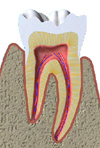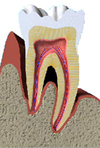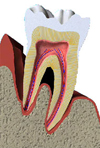First steps in a dental accident
- If necessary, stop the bleeding, preferably with a sterile dressing material that you press on the wound.
- Cool from the outside (e.g. with a wet towel or optimal cooling battery)
- Locate the tooth or broken tooth. Important: Only touch the tooth at the crown, not at the root.
- Important: do not clean the tooth!
- Keep the tooth or fragment as moist as possible.
It is best to place the tooth in a tooth rescue box (storage period 24 – 48 hours).
Alternative storage options with significantly shorter storage time (30 min to 2 hours) are: UHT milk, saliva (collected in the container), plastic film, saline solution (pharmacy)
unsuitable are: water, damp handkerchief, oral cavity, dry storage - Visit a dentist or dental clinic as soon as possible. This is also important for possible insurance claims.
Tooth rescue box
The tooth rescue box is a vessel filled with cell nutrient solution in which a knocked out tooth or the fragment of a tooth can be stored for more than 24 hours without the cells of the root surface dying. For schools or sports clubs, a purchase is recommended. The tooth rescue box is available in pharmacies.
Source: German Dental Association www.bzaek.de
further information on the subject of dental accidents
 |
 |
 |
 |
|||||











